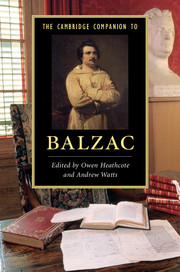Book contents
- The Cambridge Companion to Balzac
- The Cambridge Companion to Balzac
- Copyright page
- Contents
- Illustrations
- Contributors
- Acknowledgements
- Chronology
- Balzac’s Work: an Overview of ‘La Comédie humaine’
- Abbreviations
- Introduction
- 1 Balzac: A Portrait of the Novelist as Social Historian and Scientist
- 2 Balzac’s Early Works
- 3 Balzac’s Correspondence
- 4 Fantasy and Reality in La Peau de chagrin
- 5 Balzac, Money and the Pursuit of Power
- 6 Le Père Goriot: Arrivisme and the Parisian Morality Tale
- 7 Illusions perdues: Writers, Artists and the Reflexive Novel
- 8 Balzac, Gender and Sexuality: La Cousine Bette
- 9 Space, Religion and Politics in the Scènes de la vie de campagne
- 10 Balzac’s Shorter Fiction
- 11 Adapting Balzac
- 12 Balzac’s Legacy
- Epilogues
- Guide to Further Reading
- Index of Characters
- General Index
- Cambridge Companions to …
- References
Guide to Further Reading
Published online by Cambridge University Press: 09 February 2017
- The Cambridge Companion to Balzac
- The Cambridge Companion to Balzac
- Copyright page
- Contents
- Illustrations
- Contributors
- Acknowledgements
- Chronology
- Balzac’s Work: an Overview of ‘La Comédie humaine’
- Abbreviations
- Introduction
- 1 Balzac: A Portrait of the Novelist as Social Historian and Scientist
- 2 Balzac’s Early Works
- 3 Balzac’s Correspondence
- 4 Fantasy and Reality in La Peau de chagrin
- 5 Balzac, Money and the Pursuit of Power
- 6 Le Père Goriot: Arrivisme and the Parisian Morality Tale
- 7 Illusions perdues: Writers, Artists and the Reflexive Novel
- 8 Balzac, Gender and Sexuality: La Cousine Bette
- 9 Space, Religion and Politics in the Scènes de la vie de campagne
- 10 Balzac’s Shorter Fiction
- 11 Adapting Balzac
- 12 Balzac’s Legacy
- Epilogues
- Guide to Further Reading
- Index of Characters
- General Index
- Cambridge Companions to …
- References
- Type
- Chapter
- Information
- The Cambridge Companion to Balzac , pp. 200 - 206Publisher: Cambridge University PressPrint publication year: 2017

